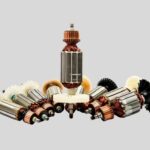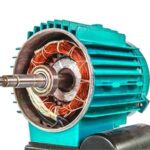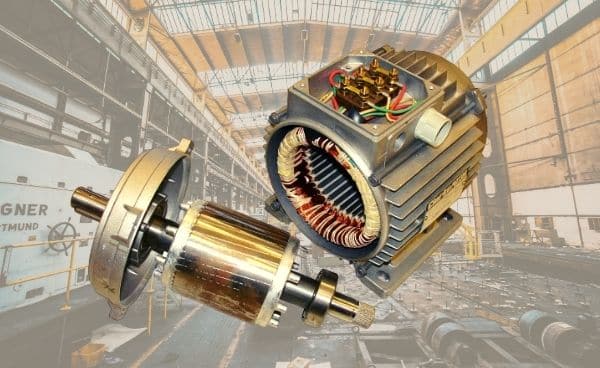Importance of Blocked Rotor Test on Motors
What Is Blocked Rotor Test?
A blocked rotor test is conducted on an induction motor. It is also known as short circuit test, locked rotor test or stalled torque test.
From this test, short circuit current at normal voltage, power factor on short circuit, total leakage reactance, and starting torque of the motor can be found.
The test is conducted at low voltage because if the applied voltage was normal voltage then the current through the stator windings would be high enough to overheat the windings and damage them.
The blocked rotor torque test is not performed on wound-rotor motors because the starting torque can be varied as desired. However, a blocked rotor current test is conducted on squirrel cage rotor motors.
Process of Testing of Blocked Rotor Test of Induction Motor
In the blocked rotor test, it should be kept in mind that the applied voltage on the stator terminals should be low otherwise normal voltage could damage the winding of the stator.
In block rotor test, the low voltage is applied so that the rotor does not rotate and its speed becomes zero and full load current passes through the stator winding.
The slip is unity related to zero speed of rotor hence the load resistance becomes zero. Now, slowly increase the voltage in the stator winding so that current reaches to its rated value.
At this point, note down the readings of the voltmeter, wattmeter and ammeter to know the values of voltage, power and current. The test can be repeated at different stator voltages for the accurate value.

This test is performed to determine the short circuit current with normal voltage applied to stator; power factor on short circuit; total equivalent of resistance and Reactance referred to stator.
- “WHAT IS THE NEXT” for Pump Industry- Internet on things (IoT) can bring Transformation in Pumping Industry
 Advancements in digital technologies are changing our world. The rapid growth of connected, intelligent devices and the decreasing cost of computing and connectivity are driving this transformation. IoT devices can collect, analyze, and exchange data. The ability to drive energy efficiency, remotely monitor and control pumping applications, and predict issues before they cause downtime or…
Advancements in digital technologies are changing our world. The rapid growth of connected, intelligent devices and the decreasing cost of computing and connectivity are driving this transformation. IoT devices can collect, analyze, and exchange data. The ability to drive energy efficiency, remotely monitor and control pumping applications, and predict issues before they cause downtime or… - 14 causes of submersible pump and motor failure
 Submersible Pump and motor failure can result in extended downtimes, repeated repairs, and higher maintenance costs. submersible pump and motor failure cause understanding can help in the selection of the pumping equipment. Here, we look at the 14 Most Common causes of submersible pump and motor failure is described below 1.Cavitation It is the rapid…
Submersible Pump and motor failure can result in extended downtimes, repeated repairs, and higher maintenance costs. submersible pump and motor failure cause understanding can help in the selection of the pumping equipment. Here, we look at the 14 Most Common causes of submersible pump and motor failure is described below 1.Cavitation It is the rapid… - 4 Most Common Causes of A Critical Failure In Submersible Motors
 Submersible motor failures can cause problems both in terms of cost and time-management, but they are preventable. Here, we explore the 4 most common causes of a critical failure in submersible motors and what you can do to avoid them. Problem no.-1 Temperature Significant changes in temperature, especially overheating, is the most common form of…
Submersible motor failures can cause problems both in terms of cost and time-management, but they are preventable. Here, we explore the 4 most common causes of a critical failure in submersible motors and what you can do to avoid them. Problem no.-1 Temperature Significant changes in temperature, especially overheating, is the most common form of… - 5 Symptoms Of Failing Electric Motor Rotor
 Motors are used everywhere in industrial environments and they are becoming increasingly complex and technical, sometimes making it a challenge to keep them running at peak performance. Use this quick guide to respond quickly and confidently when any electric motor rotor goes down. 1. Open rotor bars: Open rotor bars or end rings are usually…
Motors are used everywhere in industrial environments and they are becoming increasingly complex and technical, sometimes making it a challenge to keep them running at peak performance. Use this quick guide to respond quickly and confidently when any electric motor rotor goes down. 1. Open rotor bars: Open rotor bars or end rings are usually… - 7 Ways to Improve Electric Motor Efficiency
 From Home appliances to industrial applications Electric Motor playing significant role. So Electric motor efficiency determines how well the appliance will perform. That’s true that electric motors consume more electricity than any other type of technology in industrial and commercial applications but now a day’s due to advancement in technology energy-efficient and premium-efficiency motors manufacture…
From Home appliances to industrial applications Electric Motor playing significant role. So Electric motor efficiency determines how well the appliance will perform. That’s true that electric motors consume more electricity than any other type of technology in industrial and commercial applications but now a day’s due to advancement in technology energy-efficient and premium-efficiency motors manufacture… - A brief understanding of leakage current testing
 What Is Leakage Current? Leakage current is the current that streams from either DC or AC circuit in an equipment to the ground or framework and can be from the output or input. If the equipment is not properly grounded, the current flows through other paths such as the human body. This mighty also occurs if the ground is incompetent or is disrupted unintentionally or intentionally. The leakage current in an…
What Is Leakage Current? Leakage current is the current that streams from either DC or AC circuit in an equipment to the ground or framework and can be from the output or input. If the equipment is not properly grounded, the current flows through other paths such as the human body. This mighty also occurs if the ground is incompetent or is disrupted unintentionally or intentionally. The leakage current in an…




